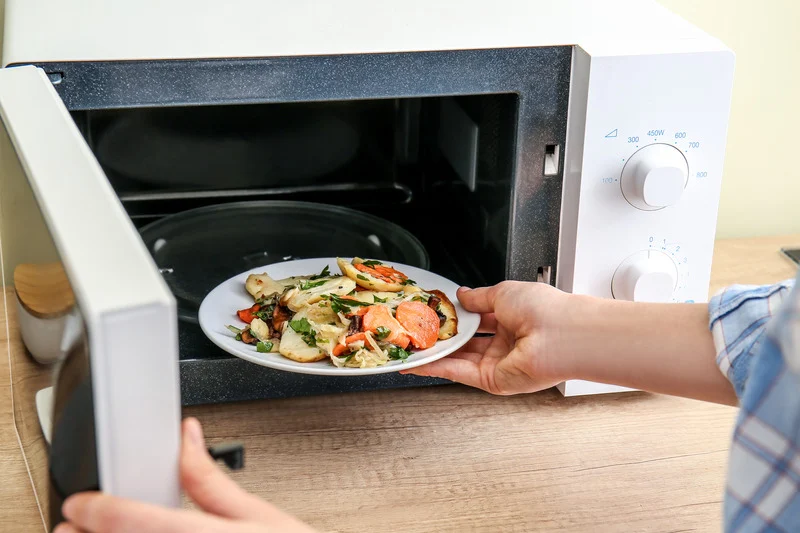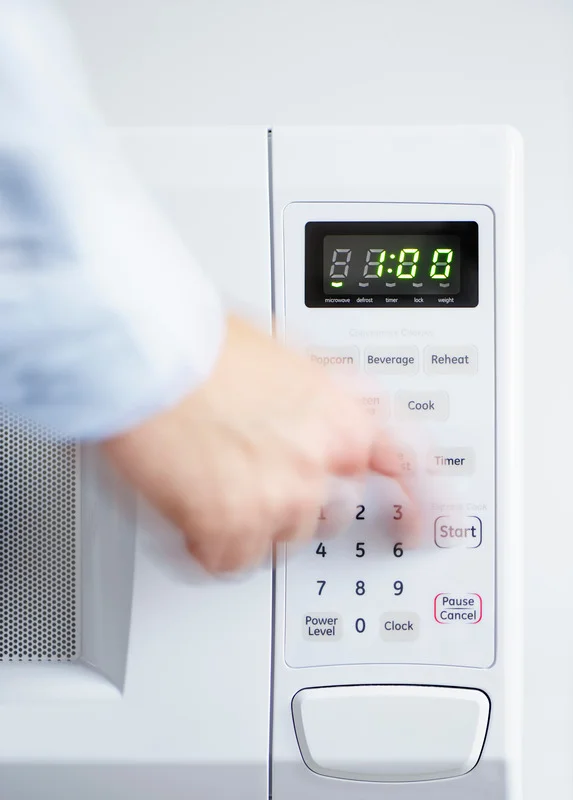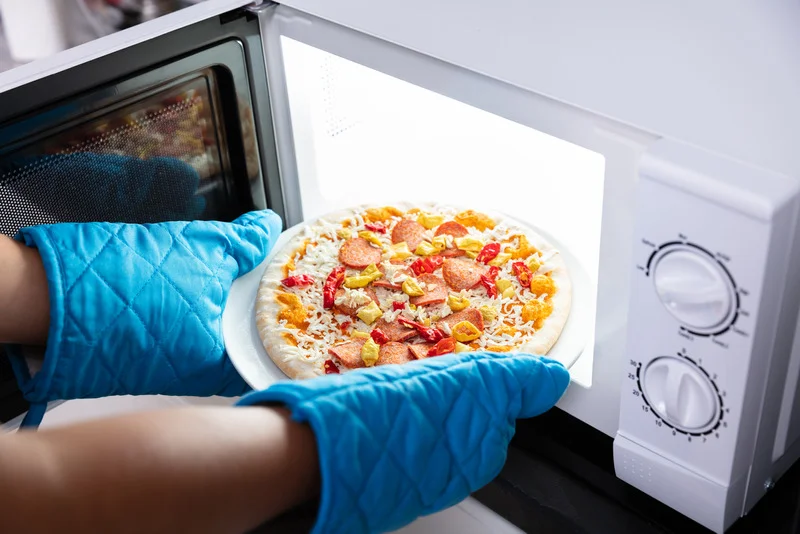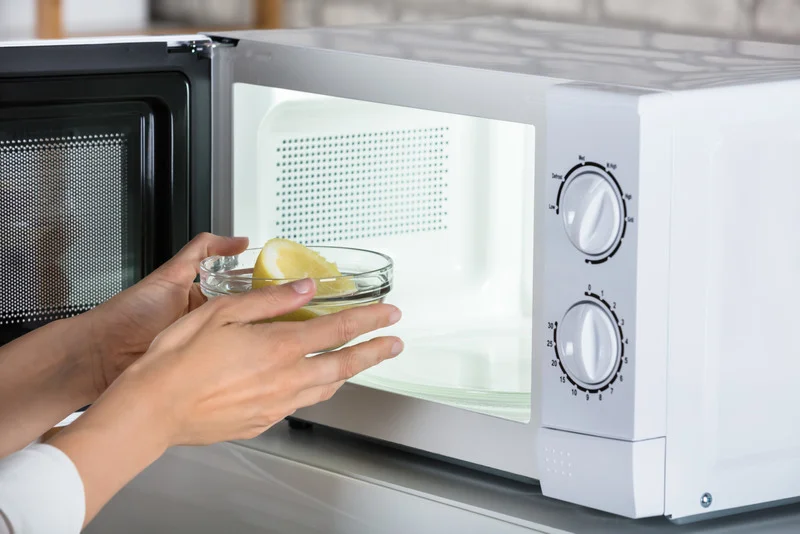In the hustle and bustle of our modern lives, the microwave has become an indispensable kitchen companion, zapping our meals to piping hot perfection in a matter of minutes. Have you ever wondered how hot your microwave can become? This helpful guide will talk about weather, things that affect heat, and more.

How Does a Microwave Work?
Microwaves produce electromagnetic waves that cause water molecules in food to vibrate fast, resulting in friction that heats the meal. This allows microwaves to rapidly heat foods from the inside out.
The magnetron tube inside the microwave turns electrical energy into high-powered 12 cm microwave radiation that gets channeled into the interior cavity. This radiation excites the water, fat, and sugar molecules, causing them to vibrate at extraordinary rates, resulting in friction and heat.
So your food is essentially being bombarded with intense energy waves that agitate its molecules into a frenzy of heating and steaming.
How Hot Does A Microwave Get?
A standard microwave operating at full power may achieve surface temperatures of 250°F (120°C) on cookware and boiled water. The majority of household microwave ovens run at power levels ranging from 500 to 1100 watts. This strong radiation can rapidly heat things to temperatures over the 212°F (100°C) required to boil water.
- Average max: 200°F or 93°C.
- High-power models: 250°F or 121°C.
- Commercial models: 300°F or 149°C.
Temperatures relate to the food item, not oven interior.
What Affects Microwave Heating?
Microwave cooking power, duration, contents, and size impact interior temperatures including:
- Wattage: Higher wattage models generate more powerful rays and quicker boiling.
- Cook times: Longer exposure results in higher temperatures at the surface and inside the food.
- Food/liquid: More microwave-receptive = hotter.
- Quantity: Larger amounts absorb more energy.
- Volume/density: More or denser food absorbs energy faster and generates heat within the oven.
- Moisture content: Because of the friction between water molecules, wet materials heat up faster than dry items.
- Placement: Uneven heating can occur if food isn’t centered properly for optimal ray coverage.
Venting and door seals release excess heat.

Time-Based Temperature Milestones
How Hot Does A Microwave Get In 10 Seconds?
When you need a quick warm-up, just 10 seconds in the microwave can increase the inside temperature by 30 degrees Fahrenheit.
How Hot Does A Microwave Get In 30 Seconds?
In 30 seconds, a 1100-watt microwave can heat 2 ounces of room temperature water to approximately 160°F. Foods begin to emit steam as moisture changes to vapor. This rapid temperature rise makes microwave cooking both convenient and time-saving.
How Hot Does A Microwave Get In 1 Minute?
A microwave may attain temperatures ranging from 100°F to more than 200°F in one minute, depending on the wattage output of the device. You can prepare food at this temperature.
How Hot Does A Microwave Get In 2 Minutes?
In two minutes, your microwave may raise the interior temperature to roughly 160 degrees Fahrenheit. Foods heavy in moisture, such as canned soup, can achieve interior temperatures of more than 200°F. Most modern microwaves halt themselves precisely at this upper heat threshold.
How Hot Does A Microwave Get In 5 Minutes?
Extend the cooking duration to five minutes, and your microwave will reach an internal temperature of around 180 degrees Fahrenheit. This controlled heat assures complete cooking without affecting the texture or flavor of your meal.

Can a Microwave Overheat?
While extremely unlikely due to built-in safeguards, it is technically possible for a microwave to overheat components due to mechanical or electrical failure issues. Signs include internal temperatures exceeding established limits or external housing reaching unsafe 200°F+ levels even when idling. At the first sign of trouble, unplug and contact manufacturer support.
What Does Your Microwave Do When It Gets Too Hot?
Most modern ovens include thermostatic controls that constantly monitor the internal temperature. When the upper 150-170°F threshold is neared, safety sensors alert the machine to automatically halt cooking and activate cooling fans to expel excess heat. The microwave will remain dormant until it has cooled sufficiently to resume operation. This function prevents dangerous overheating conditions.
How Can You Prevent Your Microwave From Getting Too Hot?
To keep your microwave functional for years:
- Never run it empty without food inside to absorb energy.
- Follow instructions precisely and avoid unnecessary time extensions.
- Remove cooked items soon afterwards to avoid lingering heat accumulation.
- Keep the cavity and door seals clean to maximize airflow.
- Allow it to cool completely between consecutive usage.
- Consider a lower-wattage model for lengthy reheating tasks.
- Keep the ventilation openings free.
- Replace the worn door seals and parts.
- Clean food trash and grease regularly.
- Do not use damaged or recalled units.
- Follow all manufacturer’s directions.
Proper use habits ensure that the microwave operates safely and efficiently without overburdening its thermal protections. Just be cautious and always monitor your meals as they cook!

Why Microwaves Don’t Reach Oven Temperatures?
Despite generating extreme heat to cook food, the oven interior doesn’t reach normal oven temperatures because:
- Heat is generated in the food, not the cavity walls.
- Microwaves excite molecules but don’t heat the air.
- Metal interiors reflect energy rather than absorbing it.
So food reaches over 200°F while the microwave stays under that.
While microwave cooking rapidly heats up foods through targeted molecular excitation, the ovens themselves don’t reach the same scorching temperatures as traditional ovens. But they still need ventilation to avoid overheating.
Conclusion
In the realm of culinary technology, the microwave stands as a testament to convenience and efficiency. Understanding how hot a microwave gets enables us to use its power appropriately. So, the next time you hear your microwave’s familiar hum, you’ll have a renewed appreciation for the controlled warmth it brings to your culinary excursions. Accept the heat, enjoy the tastes, and let your microwave be the gourmet maestro it was meant to be.

FAQs
The average temperature of a microwave on high ranges from 130°F to 140°F (54°C to 60°C). It’s important to note that microwaves don’t actually get this hot on the outside. The exterior of a microwave may not even be warm to the touch, despite the high temperatures inside.
A 700-watt microwave is like cooking something in a 350-degree oven. An 800-watt microwave is like cooking something in a 450-degree oven. A 900-watt microwave is like cooking something in a 525-degree oven.
700 Watts in microwave >> like cooking at 350 degrees 800 Watts >> 450 degrees 900 Watts >> 525 degrees (Self clean) 1000 Watts >> 575 degrees 1100 Watts >> 625 degrees (Blow torch!!)
The maximum temperature of a microwave oven is 212 degrees Fahrenheit or 100 degrees Celsius – the boiling point of water. This means that any food or liquid placed in the oven will not exceed a temperature higher than this (unless you’re using the defrost setting).
Microwaves do not generate heat like regular ovens, instead they produce microwaves that cause the water molecules in the food to vibrate and heat up. So it is not certain how hot a microwave would get in 30 seconds because it is dependent on the object inside of it. The hottest it may get would be 212°F (100°C).
High (100 percent) power is best for browning, boiling liquids, cooking or heating fish, ground meats, bacon and vegetables. Medium-High (70 percent) power is best for gentle cooking of meats and poultry, baking casseroles and convenience foods, sautéing and re-heating food.
Sources:
- How Hot Does A Microwave Get? [Microwave Temp Chart]
- How Hot Does A Microwave Get? | Get The Facts Here
- How Hot Does A Microwave Get In 1 Minute? [In-Depth Analysis]
- Microwave oven
- What Is the Highest Temperature a Microwave Can Reach?
- How Hot Does A Microwave Get?
- How Hot Does a Microwave Get?
- How Hot Does a Microwave Get in 1 Minute?
- How Hot Can a Microwave Get? A Definitive Answer
- How Hot Does a Microwave Get? Everything You Need to Know
- How hot does a microwave get in 30 seconds?
- How Hot Does A Microwave Get?
- What do you do when the exterior of your microwave gets hot?
- How Hot Does It Get In A Microwave?
- What temperature is ‘High’ in a 950 watt microwave?
- Microwave Getting Hot, Even When It’s Off? Here’s Why
- How does a microwave heat up food?
- How Hot Does a Microwave Oven Get? Maximum Temperature Explained
- Microwave Surface Temperatures too hot
- Microwave Safe Internal Food Temperature Guidelines
- How Do Microwaves Work?